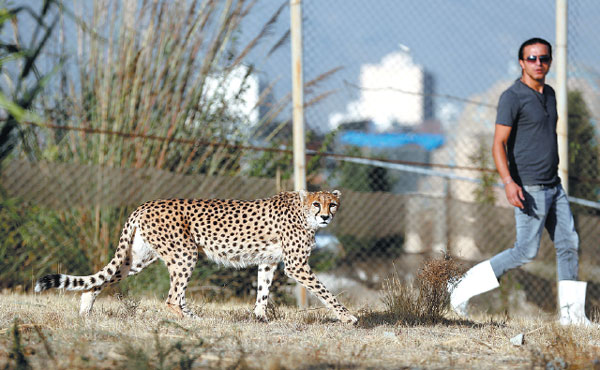Iran speeds to save last 'mascot' Asiatic cheetahs
Experts believe there are only 50 of the big cats in the wild
GARMSAR, Iran - Iranian environmentalists have mobilized to protect the world's last Asiatic cheetahs, estimated to number just 50 and faced with the threats of becoming roadkill, a shortage of prey and farmers' dogs.
"The last time our photo traps caught a cheetah here, it was two years ago. But we're sure they are still in the region," said Rajab Ali Kargar, deputy head of the National Protection Project for the Asiatic Cheetah.
His camp is just a stone's throw from an old royal hunting pavilion in the Garmsar area of Semnan province, around 120 kilometers south of Teheran, but these days the focus is on preservation rather than killing.
|
Animal trainer Mahmud Keshvari walks next to a female Asiatic cheetah named Dalbar in an enclosure at the Pardisan Park in Teheran, Iran. Atta Kenare / Agence France-presse |
The world's fastest land animal, capable of reaching speeds of 120 kilometers per hour, once stalked habitats from the eastern reaches of India to the Atlantic coast of Senegal.
Their numbers have stabilized in parts of southern Africa, but they have practically disappeared from northern Africa and Asia.
The subspecies "Acinonyx jubatus venaticus", commonly known as the Asiatic cheetah, is critically endangered, according to the International Union for Conservation of Nature, mostly due to past hunting.
Iran launched its protection project in 2001 with the support of the United Nations "when we realized Iran was the last country to have any Asiatic cheetahs", said Hooman Jokar, who heads the program.
It set up a network, now numbering 92 specially trained park wardens, who cover a total of 6 million hectares in central and northern Iran.
The Iran-Iraq war of the 1980s was devastating for wild animals, particularly along the country's western border.
It was thought for a time that the cheetahs had been wiped out, until they were found to have retreated into the central desert regions.
Major problems
Three major problems have befallen the Asiatic cheetah in recent time: cars, farmers and having nothing to eat.
"When we launched the project, the biggest danger was the lack of prey," said Jokar.
The team focused on building up numbers of gazelles and rabbits for the cheetahs to eat, which has been largely successful.
Cars and farmers remain a threat, however.
"Today, the cheetahs leave their zones and approach villages. Farmers and their dogs kill them to protect their herds," said Jokar.
In its bid to raise public awareness, the project's most successful move was putting an image of the cheetah on the national football team's jersey during the 2014 World Cup and the Asian Games in the same year.
Since early September, a new campaign, headed by popular actress Hedieh Tehrani, has raised some eight billion rials ($200,000) in just over a month as part of efforts to relocate farms in order to reduce confrontations with the cheetah.
"It's the biggest mobilization of civil society that I've witnessed," said Jokar.
There are also hopes for a cheetah couple held in captivity in one of Teheran's biggest parks, Pardisan.
A first pregnancy failed, but the wardens say it is a positive sign that they are mating.
"The females are very picky," said Kargar.
Agence France-presse
(China Daily 10/31/2017 page10)



















